Selection of Dairy Bull
Published: December 22, 2013
By: Syed Hassan Raza, M. Riaz, U. Farooq and Karamat Ullah (Dept. Livestock Management, University of Agriculture, Faisalabad)
Dairy production is one of the most important components of livestock production in which bull with high genetic potential play a critical role to gain maximum production in the next generation. The evidences show that the sire and the dam contribute equally to the inheritance of the offspring, the sire has many more offspring than the dam and therefore his influence on the herd is more than that of a cow. So a superior bull can be responsible for the improvement of the herd. But unfortunately in our country Pakistan farmers does not pay any attention on selection, age,bull-to-female ratio, housing, feeding, disease control and overall management of breeding bull. Therefore farmers should consider the following manage-mental point of views regarding bull which is going to be used for natural breeding.
Selecting a service bull is not as simple as selecting a bull that possesses correct type. Selection of the dairy bull is by far the most important decision a dairy farmer has to make.
- External appearance is a valuable consideration in selecting a dairy bull. It is seldom used as the only method of dairy bull selection. The main considerations in selecting dairy bulls are their ancestor history and the production records of the progeny. The pedigree of dairy bull is important as it contains information on production records of the sire and the dam. These informations are valuable in selecting the bull for its efficiency. The pedigree should be complete with all vital information.
- Dairy bulls are also selected on the basis of progeny performance. This is the most reliable method of selecting a bull for dairy purpose. It is generally recognized that if a bull has sired progeny of the desired characters in one herd, he will do so in another provided the dams (cows) are of good quality. Such type of bulls are also known as "proven bull". A proven bull is a sire having daughters with production records for dams.
- A proven bull is the best insurance that a breeder can have, but there are several objections to the use of a proven bull. Proven bull are more costly, it is scarce and frequently impossible to get it and takes a long time to make a bull proven and by that time he becomes old.
- When selecting a stock bull first consideration must be given to the female lines from which he has descended. After locating a bull that has descended from a long time of desirable female’s attention should then be given to the individuality of the bull himself. There is little question that a bull of good type that has descended from the right kind of females is more likely to be a herd improver than another bull descending from an equally good line of females but himself being defective in conformation. The important aspects of dairy bull type are described here.
General appearance
Attractive, revealing vigour, masculinity with harmonious blending, and correlation of parts. Impressive style and attractive carriage with an active, well balanced walk.
Breed characteristics
Head should be masculine, medium in length, clean cut broad muzzle with large open nostrils, lean strong jaw, full bright eyes, and forehead according to the breed characteristics. Shoulder blades should set smoothly against chest wall and withers. Back strong and straight with well-defined hump. Loin broad, strong and nearly level. Hips wide, approximately lever laterally with back, free from excess tissue. Thurls and pinbones wide apart, tail long, tapering with nicely balanced switch.
Dairy character
Animation, angularity, general openness and freedom from excess tissues. Neck masculine and long, with moderate crest and blending smoothly into shoulders. Clean cut throat, brisket and dewlap. Withers well defined and wedge shaped prominent according to the breed. Ribs well arched wide apart, rib bone flat, wide and long. Ranks arched and refined. Thighs when viewed from side flat, when viewed from the rear wide apart. Testicles and scrotum are normal. Skin of medium thickness, loose and pliable with fine hair. Rudimentary teats are wide apart.
Body capacity
Relatively large in proportion to the size of the animal, and deep at flank. Barrel deep, strongly supported, ribs wide apart, and well sprung. Heart girth large, resulting from long well sprung fore ribs, wide chest floor between the forelegs.
The head
The head should show reasonable length and width yet not be too large in proportion to the body. A head that is too big could potentially increase calving problems.
The neck
The neck should be of good length and held high. A bull which holds his head and neck low may in fact be straight in the shoulder. This affects the bull’s gait and mobility. A straight-shouldered bull is also likely to be straight in the hind legs, a very serious fault, leading to early breakdown.
The brisket
The brisket is one area in which fat will be deposited. The bull should be trim in the brisket, as he should be throughout his body. Overfat bulls may in fact be light in their muscle, producing progeny with lower yielding carcases.
The shoulders
The shoulders and front leg structure of the bull are shown in Figure below. The shoulders are naturally sloping. A slope of 45–60 degrees is considered acceptable. A beast whose shoulder blade is tipped forward (straight-shouldered) has less angle at the shoulder joint and elbow joint and this reduces the shock-absorbing ability of these front joints.
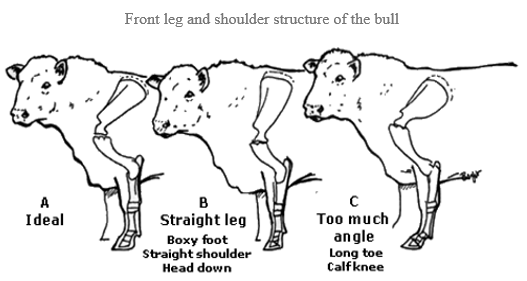
The straight-shouldered bull tends to walk with a short choppy gait. He will carry his head low and may have difficulty raising his head much above his backline. Quite often the tip of the shoulder blade is prominent above his backline.
Usually, a bull that is straight in the shoulder will also be straight in the hind leg. These bulls are particularly prone to early breakdown through the wearing of the leg joints, and the onset of arthritis.
The shoulder should be smooth against the rib cage. Bulls whose shoulders are wide at the point of the shoulder (the base of the neck) or wide between the shoulder blades (when observed from above) may throw heavily shouldered calves, increasing the chance of calving problems (see Figure below).
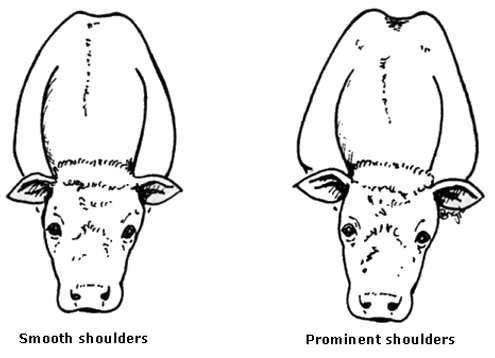
Front legs and feet
The front legs of the bull should be straight when viewed from in front. On a structurally sound animal, a vertical line may be drawn from the point of the shoulder to the middle of the claw. This line should intersect the knee (see Figure below).
As the knee joints carry more than half the bull’s body weight, deviations from this line may cause excessive wearing of these joints.
A ‘knock-kneed’ bull may have turned-out front feet (up to 10 degrees is considered normal). A bull is considered ‘knock-kneed’ when the knee joints lie inside this line, which may eventually lead to overgrown outside claws.
A bull that is wide at the knees (bow-legged) presents a more serious problem. These animals are often narrow in their stance and may roll their feet as they walk.
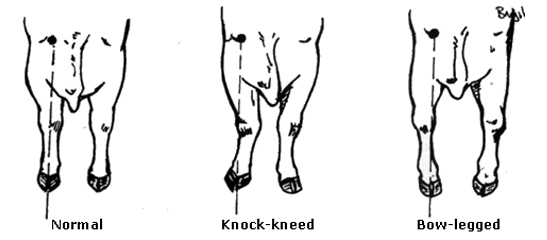
From the side, the forearm and cannon bones should be in a straight line.
The way the claws of the feet grow often indicates structural problems higher up the legs. Long or excessively short even claws may indicate too much or not enough pastern angle, causing both claws of the hoof to grow or wear excessively. Overgrown claws affect the mobility and performance of the animal. Figure below indicates the correct angle of the pastern joint.
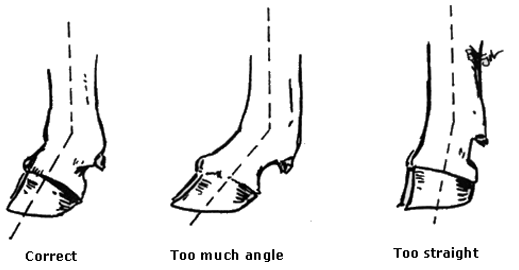
If the claws curl across each other without growing long, a serious genetic fault (‘scissorclaw’) may be apparent. These cattle wear the back of the hoof, causing lameness and reducing mobility.
Feet
Avoid overgrown, scissor or curved claws (see Figure 5). Mild curling is normal. It is exaggerated by heavy feeding and soft soils. Overgrown, uneven claws are usually indications of poor limb structure or early signs of hip arthritis. Avoid extremely short feet, which are often associated with overstraight legs.
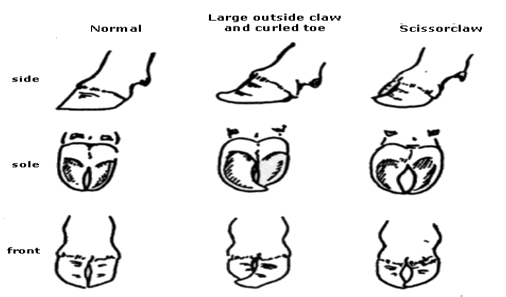
Walk
Look for a free-moving gait, with the hind feet stepping into the footprints of the front feet (see Figure 6 right). Overstepping or understepping are indications of structural problems, as are uneven footprints from the claws.
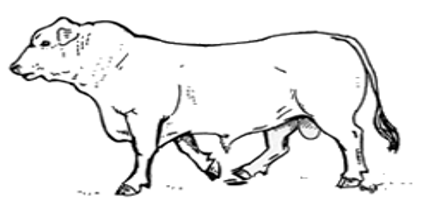
Hind legs and feet
The structure of the hind legs is similar to that of the front legs. Again there are well-defined angles in the joints at the hip, stifle, hock and pastern joints. The angles are critical, particularly during serving when large amounts of stress are placed on these joints. Deviations from the correct angles (see Figure below) will cause excessive wear and tear on the joints, leading to early breakdown. More bulls seem to break down from problems associated with the hind leg than from any other reason.
When a bull mounts a cow, he straightens up the joints in his hind leg. When he thrusts, he further straightens the leg, placing enormous stress on all joints, but particularly the hock. If these joints don’t have enough angulation, they become swollen and painful, leading eventually to their breakdown.
Straightness in the hind leg can be seen in the hock and pastern joints, and this indicates straightness in the stifle and hip. These cattle will wear the front of the claws, resulting in short upright hooves.
Straight-legged bulls are also much less athletic than the sound bull and appear to suffer a higher incidence of broken or damaged penises during serving.
A structurally correct bull, when walking, will place his hind foot in exactly the mark left by his front foot. If he is lame, or not moving freely, or if he is straight in his leg structure, he will short-step and not reach his mark. Likewise, if he is suffering arthritis in one leg he may tend to short-step or drag his leg on that side. Problems such as these will affect the serving ability of the bull.
Viewed from behind, the tibia and metatarsus (hock joint) should be in a straight line. A bull is ‘cow hocked’ when the hocks are rotated inwards and the hooves rotated outwards. This may cause problems but usually only in extreme cases where uneven pressure on the claws may cause the outside claw to grow long.
A more serious problem occurs where the legs are wide at the hocks (‘bow-legged’), but the feet are turned in. Extra strain is placed on the ligaments of the hock joints causing lameness and even permanent damage.
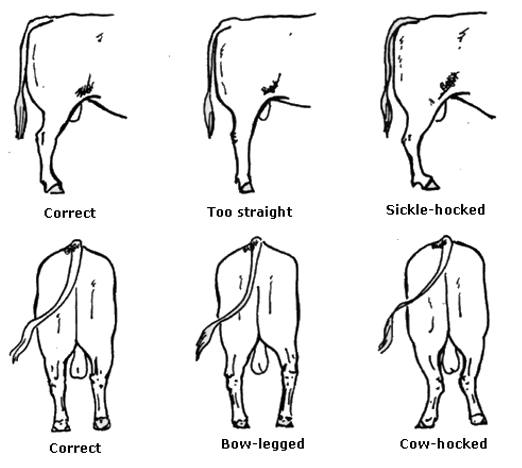
Testicles Size
Minimum Recommended Scrotal Circumference for Age
- 12 to < 15 months 30 cm
- 15 to < 18 months 31 cm
- 18 to < 21 months 32 cm
- 21 to < 24 months 33 cm
- 24 months >34cm
Selection of bulls for natural service duty in dairies should pay particular attention to physical (and reproductive) soundness, sex-drive (libido), mating ability and health.
Age of Dairy Bulls
Younger bulls (i.e. less than 2 to 2.5 years of age) are preferable to older bulls for the following reasons:
- They are more tractable and pose less danger to humans.
- They can be used in multi-sire groups with less danger of the more serious aspects of social dominance being manifest (e.g. injured bulls, broken fences).
- They have less chance of having developed degenerative or other age-related pathological or psychological problems which might lower their reproductive performance.
Although younger bulls are preferred, they should be pubertal and not of heterogeneous physical size (larger or smaller) compared with females.
Care should be taken when buying bulls from sale barns, or other situations in which animals from diverse sources are comming. Here, appropriate biosecurity measures should ensure that the dairy farm is not purchasing unwanted problems.
Authors:
Recommend
Comment
Share
Recommend
Reply
Recommend
Reply
Recommend
Reply
15 de mayo de 2020
Respected sir syed hassan raza
Hope You will be fine and enjoying good health
This article is very informative and covers all aspects of the topic. No doubt you are great asset of dairy industry and University of Agriculture Faisalabad. we, your students, really respect you and appreciate your work.
Dr. M. Zaeem Abbas
DVM, M.Phil (Silver medalist)
PhD (USPCAS)
Recommend
Reply
13 de octubre de 2019
My bull has long and large testacles but serves well is there an imminent problem that may happen in the future. Is there any correlation between long testacles with producing cows with big teats? And possibly good milk yield.
Recommend
Reply
12 de septiembre de 2017
Respected Sir this was a very informative article for me, i am interested in to learn more on this topic from you
Recommend
Reply
Recommend
Reply

Would you like to discuss another topic? Create a new post to engage with experts in the community.
Featured users in Dairy Cattle

José Manuel Oropeza Meza
MSD - Merck Animal Health
Gerente Nacional Cuentas Clave en MSD Salud Animal
United States
United States












